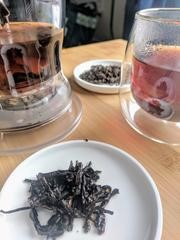So exciting! This is the first week of my Tea 101 course. Still have no idea why I signed up except that when I got an envelope full of tea, I was excited! This first week we have to drink, taste and evaluate 5 different teas. The first one I chose was the China Pu-erh. It’s interesting the different characteristics that you consider when tasting a tea. The criteria or variable considered when tasting a tea are,
Tea tasting criteria
- Name of the tea
- Origin
- Type
- Region
- Dry leaf appearance
- Wet leaf appearance
- Infused liquor analysis
- Aroma analysis
- Flavour analysis
Lot of “analysis” towards the end; demographic type information about the tea to start; descriptive qualities about the tea leaves and the steeped tea or liquor, as it seems to be called; and then the “analysis” part for the aroma and flavour of the tea seems very qualitative and subjective.
This is what I got for the China Pu’erh,
China Pu’erh Tea Analysis
| Name of the tea | China Pu’erh |
| Type | Pu’erh (fermented black tea) |
| Origin | China |
| Region | Yunnan province |
| Dry leaf appearance | cut, flaky, ragged, stalky, clean |
| Wet leaf appearance | bright; dark brown, almost black and shiny; almost looks like seaweed; black/dark |
| Infused liquor analysis | colour is rich, reddish brown almost like mahogany; bright, even though it is a dark colour |
| Aroma analysis | light, subtle, no strong aroma or taste. |
| Flavour analysis | soft, thin, plain, easy to drink; doesn’t require anything like milk or sweetener; smoothness and freshness to the taste |
My general comments about the pu’erh teas, I like them. They don’t have that after taste or slightly bitter taste that some teas have, usually the black teas. Those require some milk to really enjoy them. The pu’erh’s don’t have that grassy, weedy taste that some green teas have. The pu’erhs don’t have that acidic, astringent taste that some teas have, usually herbal or fruity ones or anything that seems to come from a flower or fruit if steeped too long. I’m surprised the pu’erh’s taste so smooth and nice give that they are a black type tea and have, I think, have a high caffeine level. Perhaps it’s the fermentation process.

Above we can see a picture of the liquor or steeped tea of the China pu’erh. It has a nice reddish, rich brown colour that is almost warm and inviting. It’s a rich colour, almost like you’d want to stain furniture this colour.

Above we can see the dry leaves and the wet leaves of the China pu’erh tea together. There was a barky brown colour to the dry leaves, almost dusty, but very nice warm brown colour. All the leaves were very distinct.

Above we can see the wet leaves of the China pu’erh tea. There was a richness to the black or dark brown colour of the wet leaves. It was kind of nice. Reminded me of seaweed, in a good way!
- My first time making scones - March 26, 2024
- Disappointing Visits to the Ripon and Plateau Farmers Markets - September 30, 2023
- The Ultimate Guide to Frozen Raw Dog Food: Benefits, Selection, and Transition Tips - September 25, 2023











